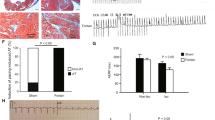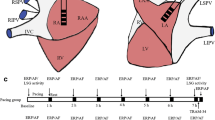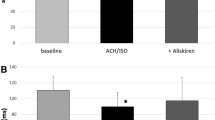Abstract
Background
Atrial tachyarrhythmia (AT) is a common complication in patients who have undergone a Fontan operation. In this study, we investigated whether abnormal Ca2+ handling contributes to the Fontan operation-related atrial arrhythmogenic substrate.
Methods
Mongrel dogs were randomly assigned to sham and Fontan groups. The Fontan operation model was developed by performing an atriopulmonary anastomosis. After 14 days, an electrophysiological study was performed to evaluate the AT vulnerability. Ca2+ handling properties were measured by loading atrial cardiomyocytes (CMs) with fura-2 AM. The L-type Ca2+ (ICa−L) and Na+–Ca2+ exchanger (INCX) currents of the CMs were recorded by the whole-cell patch-clamp technique. The key Ca2+ handling proteins expression was assessed by Western blotting.
Results
The AT inducibility was higher in the Fontan group than in the sham group (85.71 vs. 14.29%, P < 0.05). The Fontan operation resulted in decreased Ca2+ transient (CaT) amplitude and sarcoplasmic reticulum (SR) Ca2+ content, but in enhanced diastolic intracellular Ca2+ concentration and SR Ca2+ leak in the atrial CMs. The spontaneous CaT events, triggered ectopic activity and INCX density were increased, but ICa−L density was reduced in CMs from the Fontan atria (all P < 0.05). Additionally, the Fontan operation resulted in decreased SR Ca2+ ATPase expression and Cav1.2 expression, but in increased NCX1 and Ser2814-phosphorylated ryanodine receptor 2. The calmodulin-dependent protein kinase II expression and function were markedly enhanced in the Fontan atria.
Conclusion
The Fontan operation caused atrial CM Ca2+ handling abnormalities that produced arrhythmogenic-triggered activity and increased vulnerability to AT in experimental Fontan dogs.










Similar content being viewed by others
References
Fontan F, Baudet E. Surgical repair of tricuspid atresia. Thorax. 1971;26:240–8.
Giannakoulas G, Dimopoulos K, Yuksel S, Inuzuka R, Pijuan-Domenech A, Hussain W, et al. Atrial tachyarrhythmias late after Fontan operation are related to increase in mortality and hospitalization. Int J Cardiol. 2012;157:221–6.
Stephenson EA, Lu M, Berul CI, Etheridge SP, Idriss SF, Margossian R, et al. Arrhythmias in a contemporary Fontan cohort: prevalence and clinical associations in a multicenter cross-sectional study. J Am Coll Cardiol. 2010;56:890–6.
Ghai A, Harris L, Harrison DA, Webb GD, Siu SC. Outcomes of late atrial tachyarrhythmias in adults after the Fontan operation. J Am Coll Cardiol. 2001;37:585–92.
Gelatt M, Hamilton RM, McCrindle BW, Gow RM, Williams WG, Trusler GA, et al. Risk factors for atrial tachyarrhythmias after the Fontan operation. J Am Coll Cardiol. 1994;24:1735–41.
Clift P, Celermajer D. Managing adult Fontan patients: where do we stand? Eur Respir Rev. 2016;25:438–50.
Correa R, Sherwin ED, Kovach J, Mah DY, Alexander ME, Cecchin F, et al. Mechanism and ablation of arrhythmia following total cavopulmonary connection. Circ Arrhythm Electrophysiol. 2015;8:318–25.
Ruckdeschel ES, Kay J, Sauer WH, Nguyen DT. Atrial fibrillation ablation without pulmonary vein isolation in a patient with Fontan palliation. Cardiac Electrophysiol Clin. 2016;8:161–4.
de Groot NM, Zeppenfeld K, Wijffels MC, Chan WK, Blom NA, Van der Wall EE, et al. Ablation of focal atrial arrhythmia in patients with congenital heart defects after surgery: role of circumscribed areas with heterogeneous conduction. Heart Rhythm. 2006;3:526–35.
Dobrev D, Wehrens XH. Calcium-mediated cellular triggered activity in atrial fibrillation. J Physiol. 2017;595:4001–8.
Nishida K, Qi XY, Wakili R, Comtois P, Chartier D, Harada M, et al. Mechanisms of atrial tachyarrhythmias associated with coronary artery occlusion in a chronic canine model. Circulation. 2011;123:137–46.
Sipido KR, Callewaert G. How to measure intracellular [Ca2+] in single cardiac cells with fura-2 or indo-1. Cardiovasc Res. 1995;29:717–26.
Meng D, Feng L, Chen XJ, Yang D, Zhang JN. Trimetazidine improved Ca2+ handling in isoprenaline-mediated myocardial injury of rats. Exp Physiol. 2006;91:591–601.
Voigt N, Heijman J, Wang Q, Chiang DY, Li N, Karck M, et al. Cellular and molecular mechanisms of atrial arrhythmogenesis in patients with paroxysmal atrial fibrillation. Circulation. 2014;129:145–56.
Cha TJ, Ehrlich JR, Zhang L, Shi YF, Tardif JC, Leung TK, et al. Dissociation between ionic remodeling and ability to sustain atrial fibrillation during recovery from experimental congestive heart failure. Circulation. 2004;109:412–8.
Izumi G, Senzaki H, Takeda A, Yamazawa H, Takei K, Furukawa T, et al. Significance of right atrial tension for the development of complications in patients after atriopulmonary connection Fontan procedure: potential indicator for Fontan conversion. Heart Vessels. 2017;32:850–5.
Li SJ, Wong SJ, Cheung YF. Atrial and ventricular mechanics in patients after Fontan-type procedures: atriopulmonary connection versus extracardiac conduit. J Am Soc Echocardiogr. 2014;27:666–74.
Guerrero-Hernández A, Ávila G, Rueda A. Ryanodine receptors as leak channels. Eur J Pharmacol. 2014;739:26–38.
Bers DM. Cardiac excitation–contraction coupling. Nature. 2002;415:198–205.
Sobie EA, Guatimosim S, Gómez-Viquez L, Song LS, Hartmann H, Jafri MS, et al. The Ca2+ leak paradox and “rogue ryanodine receptors”: SR Ca2+ efflux theory and practice. Prog Biophys Mol Biol. 2006;90:172–85.
Bers DM. Macromolecular complexes regulating cardiac ryanodine receptor function. J Mol Cell Cardiol. 2004;37:417–29.
Bers DM, Despa S, Bossuyt J. Regulation of Ca2+ and Na+ in normal and failing cardiac myocytes. Ann N Y Acad Sci. 2006;1080:165–77.
Shannon TR, Pogwizd SM, Bers DM. Elevated sarcoplasmic reticulum Ca2+ leak in intact ventricular myocytes from rabbits in heart failure. Circ Res. 2003;93:592–4.
Yeh YH, Wakili R, Qi XY, Chartier D, Boknik P, Kääb S, et al. Calcium-handling abnormalities underlying atrial arrhythmogenesis and contractile dysfunction in dogs with congestive heart failure. Circ Arrhythm Electrophysiol. 2008;1:93–102.
Heijman J, Voigt N, Nattel S, Dobrev D. Cellular and molecular electrophysiology of atrial fibrillation initiation, maintenance, and progression. Circ Res. 2014;114:1483–99.
Andrade J, Khairy P, Dobrev D, Nattel S. The clinical profile and pathophysiology of atrial fibrillation. Circ Res. 2014;114:1453–68.
Wolf CM, Seslar SP, den Boer K, Juraszek AL, McGowan FX, Cowan DB, et al. Atrial remodeling after the Fontan operation. Am J Cardiol. 2009;104:1737–42.
Abrams DJ, Earley MJ, Sporton SC, Kistler PM, Gatzoulis MA, Mullen MJ, et al. Comparison of noncontact and electroanatomic mapping to identify scar and arrhythmia late after the Fontan procedure. Circulation. 2007;115:1738–46.
Yap SC, Harris L, Downar E, Nanthakumar K, Silversides CK, Chauhan VS. Evolving electroanatomic substrate and intra-atrial reentrant tachycardia late after Fontan surgery. J Cardiovasc Electrophysiol. 2012;23:339–45.
Funding
This work was supported by the National Natural Science Foundation of China (no. 81870248, 81300138), Scientific Research Program of Shanghai Science and Technology Commission (no. 13430721700) and the Jiangsu Provincial Medical Youth Talent (QNRC2016761).
Author information
Authors and Affiliations
Contributions
WPZ designed the study, recorded the iron currents and measured cell contraction and Ca2+ fluorescence, and wrote the paper. FL designed the study. JJW did in vivo electrophysiological study. YNL performed the procedures of Fontan operation. YJQ was involved in Western blotting and histological analysis. All authors have read and approved the final manuscript.
Corresponding author
Ethics declarations
Ethical approval
All animal-handling procedures followed the National Institutes of Health guidelines and were approved by the Shanghai Children’s Medical Center Animals Research Ethics Committee. No financial or nonfinancial benefits have been received or will be received from any party related directly or indirectly to the subject of this article.
Conflict of interest
None declared.
Rights and permissions
About this article
Cite this article
Zhou, WP., Li, F., Wu, JJ. et al. Calcium-handling abnormalities underlying atrial arrhythmogenesis in a Fontan operation canine model. World J Pediatr 14, 576–584 (2018). https://doi.org/10.1007/s12519-018-0177-z
Received:
Accepted:
Published:
Issue Date:
DOI: https://doi.org/10.1007/s12519-018-0177-z




